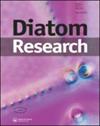DNA条形码技术揭示了一种新的铁饼属植物
IF 1.3
3区 生物学
Q2 MARINE & FRESHWATER BIOLOGY
引用次数: 1
摘要
围绕木盘的物种复合体的分类状况存在争议。物种描述和化石类型材料的不足导致了持续的混乱。h本文章由计算机程序翻译,如有差异,请以英文原文为准。
DNA barcoding reveals a new species of Stephanodiscus Ehrenberg
The taxonomic situation of the species complex around Stephanodiscus minutulus/parvus is controversial. Insufficient species description and fossil type material contribute to persistent confusion. Håkansson & Kling (1990) described S. binatus as another morphologically similar species in this group. Following the reinvestigation of the type materials of S. minutulus and S. parvus by Houk et al. (2014), it seems that these names are often falsely applied to S. binatus. Monoclonal strains of the S. minutulus/parvus/binatus species complex from European water bodies were established for morphological and molecular analyses. Most of the strains belonged to S. binatus, which seems to be very common in meso- to eutrophic waters in middle Europe. Differing in the barcoding markers, the remaining strains represented a new species, S. neglectus sp. nov., morphologically similar to S. binatus. Stephanodiscus minutulus and S. parvus were not found. Seven strains of S. neglectus sp. nov., seven strains of S. binatus and two strains of Cyclostephanos invisitatus were subjected to detailed morphometric investigation. Four strains of Stephanodiscus hantzschii, Stephanodiscus neoastrea, Cyclostephanos dubius were also included in the molecular analysis. The morphological differential diagnosis of S. neglectus sp. nov. from S. binatus is difficult, but the molecular results show that the species are distinctly different. Using three different loci the distance between the new species and S. binatus equals the distance between S. binatus and S. hantzschii.
求助全文
通过发布文献求助,成功后即可免费获取论文全文。
去求助
来源期刊

Diatom Research
生物-海洋与淡水生物学
CiteScore
2.70
自引率
16.70%
发文量
27
审稿时长
>12 weeks
期刊介绍:
Diatom Research is the journal of the International Society for Diatom Research. The journal is published quarterly, in March, June, September and December, and welcomes manuscripts on any aspect of diatom biology.
In addition to full-length papers, short notes and reviews of recent literature are published which need not contain all the sections required for full-length papers; we see these as being necessary to record information which is of interest but which cannot be followed up in detail. Discursive “Opinion” papers are encouraged which would not necessarily follow the normal lay-out. If extremely long papers are to be offered, the author(s) should contact the editors first to discuss any problems. Book reviews, obituaries and meeting reports can be published. All papers will be subject to critical review by the editors and referees, as appropriate to their content. Papers will be accepted in English only.
 求助内容:
求助内容: 应助结果提醒方式:
应助结果提醒方式:


